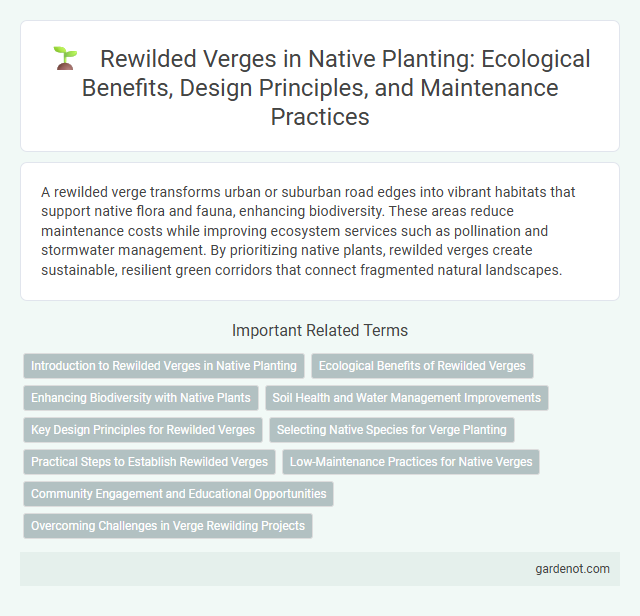A rewilded verge transforms urban or suburban road edges into vibrant habitats that support native flora and fauna, enhancing biodiversity. These areas reduce maintenance costs while improving ecosystem services such as pollination and stormwater management. By prioritizing native plants, rewilded verges create sustainable, resilient green corridors that connect fragmented natural landscapes.
Introduction to Rewilded Verges in Native Planting
Rewilded verges are strips of land along roadsides or pathways that are restored with native plant species to enhance biodiversity and support local ecosystems. Incorporating native grasses, wildflowers, and shrubs creates habitats for pollinators, birds, and small mammals while improving soil health and reducing maintenance needs. These naturalized spaces contribute to ecological resilience by reconnecting fragmented habitats and promoting the growth of indigenous flora.
Ecological Benefits of Rewilded Verges
Rewilded verges provide essential habitats for pollinators, increasing biodiversity and supporting native flora and fauna. These natural roadside areas improve soil health through enhanced organic matter and microbial activity, promoting ecological resilience. They also contribute to stormwater management by reducing runoff and filtering pollutants, helping maintain local water quality.
Enhancing Biodiversity with Native Plants
Rewilded verges transform roadside areas into thriving habitats by incorporating native plants that support local wildlife and increase biodiversity. These native species provide essential food sources and shelter for pollinators, birds, and small mammals, promoting ecological balance. Establishing diverse plant communities on verges strengthens ecosystem resilience and contributes to the restoration of natural landscapes.
Soil Health and Water Management Improvements
Rewilded verges enhance soil health by increasing organic matter and microbial activity, which boosts nutrient cycling and soil structure. Native plants adapt to local water availability, reducing runoff and promoting groundwater recharge through deep root systems. These ecological improvements support biodiversity and create resilient landscapes that better manage stormwater and prevent erosion.
Key Design Principles for Rewilded Verges
Rewilded verges enhance urban biodiversity by prioritizing native plant species that support local wildlife and pollinators. Key design principles include selecting drought-tolerant, low-maintenance plants with deep root systems to improve soil health and reduce erosion. Integrating layered vegetation structures creates microhabitats and ensures year-round ecological benefits.
Selecting Native Species for Verge Planting
Selecting native species for rewilded verge planting supports local biodiversity by providing habitat for indigenous pollinators and wildlife. Prioritize plants adapted to regional soil and climate conditions, such as native grasses, wildflowers, and shrubs that require minimal maintenance. Incorporating species like Echinacea purpurea, Solidago canadensis, and Asclepias tuberosa enhances ecological resilience and encourages natural regeneration.
Practical Steps to Establish Rewilded Verges
Establishing rewilded verges begins with selecting native plant species adapted to local soil and climate conditions, promoting biodiversity and ecological resilience. Preparing the site by removing invasive species and minimizing soil disturbance helps native plants establish strong root systems. Regular monitoring and adaptive management, such as targeted weeding and supplemental watering during dry periods, ensure successful growth and habitat development over time.
Low-Maintenance Practices for Native Verges
Rewilded verges embrace low-maintenance practices by utilizing native plant species adapted to local climates and soil conditions, reducing the need for watering, fertilizing, and mowing. These native plants support biodiversity by providing habitat and food sources for pollinators, birds, and other wildlife while enhancing soil health through deep root systems. Incorporating seasonal pruning and mulching further minimizes maintenance efforts and promotes a sustainable verge ecosystem that aligns with ecological restoration goals.
Community Engagement and Educational Opportunities
Rewilded verges provide valuable community engagement by fostering local participation in native planting projects that enhance biodiversity and ecological health. These green spaces serve as outdoor classrooms, offering educational opportunities for schools, environmental groups, and residents to learn about native flora, pollinators, and sustainable land management. Collaborative efforts in rewilding verges strengthen community bonds while promoting environmental stewardship and awareness.
Overcoming Challenges in Verge Rewilding Projects
Rewilded verge projects face challenges such as soil contamination, invasive species, and limited community engagement, which require targeted soil remediation techniques, strategic removal of non-native plants, and inclusive public awareness campaigns. Successful verge rewilding improves local biodiversity by restoring native plant habitats, supporting pollinators, and enhancing ecosystem resilience in urban environments. Integrating adaptive management practices and continuous monitoring ensures long-term ecological benefits and sustainable native planting outcomes.
Rewilded verge Infographic

 gardenot.com
gardenot.com